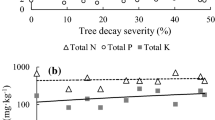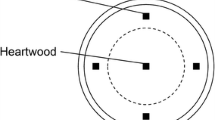Abstract
The susceptibility of Scots pine (Pinus sylvestris L.) sap- and heartwood against the wood decaying brown-rot fungus (Coniophora puteana) was investigated after long-term forest fertilization at three different sites in central Finland. Different wood properties: wood extractives, wood chemistry, and wood anatomy were used to explain sap- and heartwood decay. Scots pine sapwood was more susceptible to decay than its heartwood. In one site, sapwood seemed to be more resistant to wood decay after forest fertilization whereas the susceptibility of heartwood increased. Significant changes in the sapwood chemistry were found between treatment and sites, however, no relationship between wood chemistry and wood decay was observed in the factor analysis. The results of this study show that there was an inconsistent relationship between decay susceptibility and fertilization and the measured physical and chemical attributes of the wood were not consistently correlated with the decay rate.



Similar content being viewed by others
References
Anttonen S, Manninen A-M, Saranpää P, Kainulainen P, Linder S, Vapaavuori E (2002) Effects of long-term nutrient optimisation on stem wood chemistry in Picea abies. Trees 16:386–394
Bell AA (1980) The time sequence of defense. In: Horsfall JG, Cowling EB (eds) Plant diseases: An advanced treatise, vol. 5. How plants defend themselves. Academic press, New York, NY, pp 534, 53–73
Cajander AK (1949) Forest types and their significance. Suomen metsätieteellinen seura, Helsinki, 71 pp
Ericsson T, Fries A (1999) High heritability for heartwood in north Swedish Scots pine. Theor Appl Genet 98:732–735
Franklin GL (1945) Preparation of thin sections of synthetic resins and wood-resin composites, and a new macerating method for wood. Nature (London) 155:51
Fries A (1999) Heartwood and sapwood variation in mature provenance trials of Pinus sylvestris. Silvae Genet 48(1):30:7–14
Green F III, Highley TL (1997) Mechanism of brown-rot decay: paradigm or paradox. Int Biodeter Biodegr 39:113–124
Hannrup B, Ekberg I, Persson A (2000) Genetic correlations among wood, growth capacity and stem traits in Pinus sylvestris. Scand J For Res 15:161–170
Hansen J, Møller I (1975) Percolation of starch and soluble carbohydrates from plant tissue for quantitative determination with anthrone. Anal Biochem 68:87–94
Harju AM, Kainulainen P, Venäläinen M, Tiitta M, Viitanen H (2002) Differences in resin acid concentration between brown-rot resistant and susceptible Scots pine heartwood. Holzforschung 56:479–486
Harju AM, Venäläinen M, Anttonen S, Vapaavuori E, Viitanen H, Kainulainen P, Saranpää P (2003) Chemical factors affecting brown-rot decay resistance of Scots pine heartwood. Trees 17:263–268
Hart JH, Shrimpton DM (1979) Role of stilbenes in resistance of wood to decay. Phytopathology 69:1138–1143
Hillis WE (1987) Heartwood and tree exudates. Springer-Verlag, Berlin, Germany, 268 pp
Manninen A-M, Tarhanen S, Vuorinen M, Kainulainen P (2002) Comparing the variation of needle and wood terpenoids in Scots pine provenances. J Chem Ecol 28:211–228
Mäkinen H, Saranpää P, Linder S (2002a) Wood-density variation of Norway spruce in relation to nutrient optimization and fibre dimensions. Can J For Res 32:185–194
Mäkinen H, Saranpää P, Linder S (2002b) Effect of growth rate on fibre characteristics in Norway spruce (Picea abies (L.) Karst.). Holzforschung 56:449–460
Nerg A-M, Heijari J, Noldt U, Viitanen H, Vuorinen M, Kainulainen P, Holopainen JK (2004) Significance of wood terpenoids in the resistance of Scots pine provenances against the Old house borer, Hylotrupes bajulus, and Brown-rot fungus, Coniophora puteana. J Chem Ecol 30:125–141
Paajanen L, Viitanen H (1989) Decay fungi in Finnish houses on the basis of inspected samples from 1978 to 1988, The International Research Group on Wood Preservation, IRG Doc. No: IRG/WP/1401, 1989, 4 pp
Petric B, Scukanec V (1973) Volume percentage of tissues in wood of conifers in Yugoslavia. IAWA Bull 2:3–7
Rao PS (1982) Natural durability of woods versus their chemical composition. J Ind Acad Wood Sci 13:3–20
Rennerfelt E, Nacht G (1955) The fungicidal activity of some constituents form heartwood of conifers. Svensk Bot Tidskr 49:419–432
Saarsalmi A, Mälkönen E (2001) Forest fertilization research in Finland: A literature review. Scand J For Res 16:514–535
SCAN-CM (1994) Asetoniin liukenevan aineen määrittäminen (in Finnish). Scandinavian pulp, paper and board testing committee, 50, 4 pp
Shain L (1995) Stem defense against pathogens. In: Gartner BL (ed) Plant stems: Physiology and functional morphology. Academic Press, San Diego, California, pp 383–406
Taylor AM, Gartner BL, Morrell JJ (2002) Heartwood formation and natural durability – a review. Wood Fiber Sci 34:587–611
Taylor AM, Gartner BL, Morrell JJ (2003) Co-incident variations in growth rate and heartwood extractive concentration in Douglas-fir. Forest Ecol Manage 186:257–260
Turtola S, Manninen A-M, Holopainen JK, Levula T, Raitio H, Kainulainen P (2002) Secondary metabolite concentrations and terpene emissions of Scots pine xylem after long-term forest fertilization. J Environ Qual 31:1694–1701
Venäläinen M, Harju A, Nikkanen T, Paajanen L, Velling P, Viitanen H (2001) Genetic variation in the decay resistance of Siberian larch (Larix sibirica Ledeb.) wood. Holzforschung 55:1–6
Venäläinen M, Harju AM, Kainulainen P, Viitanen H, Nikulainen H (2003) Variation in the decay resistance and its relationship with other wood characteristics in old Scots pines. Ann For Sci 60:409–417
Venäläinen M, Harju AM, Saranpää P, Kainulainen P, Tiitta M, Velling P (2004) The concentration of phenolics in brown-rot decay resistant and susceptible Scots pine heartwood. Wood Sci Technol 38:109–118
Viitanen H, Paajanen L, Nikkanen T, Velling P (1998) Decay resistance of Siberian larch wood against brown rot fungi. Part 2. The effect of genetic variation. The International Research Group on Wood Preservation, Stockholm. Doc. IRG/WP 98-10287. 6 p
Yang RC, Wang EIC, Micko MM (1988) Effects of fertilization on wood density and tracheid length of 70-year-old lodgepole pine in west-central Alberta. Can J For Res 18:954–956
Acknowledgements
The Graduate School in Forest Sciences and the Academy of Finland (Research Council for Biosciences and Environment, projects no. 43159 and 45066) have financially supported this research. We thank Terhi Vuorinen, Hanna Nikulainen, Jaana Rissanen and Juhani Tarhanen for help with the chemical analysis, the Finnish Forest Research Institute personnel for carrying out the sampling at study sites and Ewen MacDonald for revising the language
Author information
Authors and Affiliations
Corresponding author
Rights and permissions
About this article
Cite this article
Heijari, J., Nerg, AM., Kaakinen, S. et al. Resistance of Scots pine wood to Brown-rot fungi after long-term forest fertilization. Trees 19, 729–735 (2005). https://doi.org/10.1007/s00468-005-0002-x
Received:
Accepted:
Published:
Issue Date:
DOI: https://doi.org/10.1007/s00468-005-0002-x




